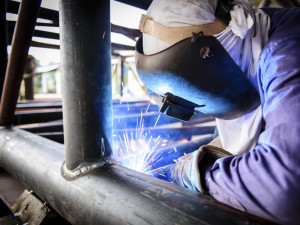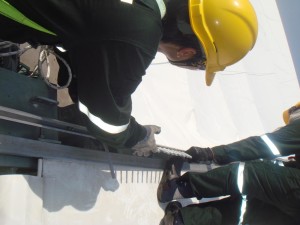The coated tensile fabric structure consists of a base layer of matting coated on both sides. The matting or cloth is created by weaving fibres perpendicular to each. The coating of the tensile membrane provides protection and stability to the tensile membrane.
Typically, the tensile strength of a membrane would be about 10 tonnes in both directions along the matting fibres.
Tensile Fabric Structures Specialists
A Tensile Fabric Structures Specialist is usually engaged to design tensile fabric structures. They often require a built in safety factor of six. This would then reduce a tensile membrane’s rated strength of 10 tonnes per linear metre to a maximum permissible load on the tensile fabric structure of about 1.7 tonnes per linear metre. Typical pre-stress load on the tensile membrane in this case would be in the neighborhood of 150-350 kg /metre.
Once a tensile membrane has reached its full pretension it will not creep under load.
Testing the Fabric
Tensile fabric specialists test fabric structure in both thread directions at load ratios generated by a computer model of the requirements for the Tensile Fabric Structures Specialist. The results are expressed as percentage compensation and are factored into the patterning software. For instance, the tensile membrane for a fabric roof would be manufactures smaller than required to allow it to tension out to cover the structure.
Two Main Choices
For external use such as fabric roofs or Tensile Fabric Structures Specialist there are two main choices of tensile membrane. One is constructed with a base coat of polyester covered with PVC. The other is a base coat of fibreglass covered with Teflon.
Since PVC is susceptible to Ultra Violet degradation the PVC coated polyester tensile fabric has UV stabilizers , fire retardants, colouring and antifungal additives available as well as a choice of Fluorinated Polymer lacquers that can enhance the cleanability of the membrane.
Using the non-weldable Polymer treated tensile membrane requires that the lacquers be removed from the edges before they are welded. This will extend the life span of tensile fabric structures by as much as five years over the life span of a weldable tensile membrane.
The structural life span of the PVC coated tensile membrane is in excess of 20 years but the esthetic life span of a tensile fabric building using PVC coated membrane will be shorter due to the plasticizers that migrate to the surface and degrade the cleanablity and appearance of the structure.
Coating While Under Stress
Many ensile membrane structures specialists coat the tensile fabric matting while it is under stress. This method is known as the Precontraint method and it imparts a more even stretch to the finished tensile membrane.
The Teflon coated tensile membrane is manufactured with inert components. This makes it a superior choice for permanent tensile fabric structures with design life spans beyond 15 year. The anticipated life span of Tensile Fabric Structures Specialist using Teflon coated fibreglass is 25 to 30 years.
When new, the Teflon coated membrane is a buff colour but it quickly bleaches to white in direct sunlight. Any weld discolouration will bleach out in the same time.
A mesh fabric is a cloth that has an open weave with gaps between the tensile fibres. Depending on the design criteria set by the tensile fabric structure specialists, the fibre bundles may be coated before they are woven.
Meshes Are Available
Meshes are available in the same composition as the tensile membrane. They are primarily used as interior shade cloth but are also available in a version constructed of fibreglass mesh coated with a clear laminate. The result is a weatherproof tensile fabric with a 50% translucency.
Uncoated Natural Canvas
Uncoated natural canvas can be used where texture is important. It is not as stable as tensile membranes, has a much shorter life span and is much harder to clean and maintain. Modified acrylic canvas provides the designer with a similar texture option but with a higher fire rating. It is much more stable than natural canvas but neither is suitable for large spans.
There are three fabrics commonly used for interiors …
Cotton
The most economical but least suited for long term use is cotton. It can provide a softer texture in multi colours but is susceptible to shrinkage and staining.
PVC coated glass cloth is suitable for theatre gauze of sunscreen and is quite durable
Silicone
Silicone coated fibreglass cloth tends to attract dirt but offers a high fire resistance and low fore toxicity.
Glass Cloth
Where sprinkler systems are above the suspended fabric open mesh must be used to meet fire codes. In this application, pure glass cloth is the best choice.
A good Tensile Fabric Structures Specialist will know exactly which type of fabric to use for your structure.
Additional reading which addresses about Fabric Roof.
Tag:- Tensile Membrane Structures Company, Tensile Fabric Structures Malaysia, Membrane Structures, Tensile Fabric Structures Specialist, Fabric Roof, Fabric Structures, Tensile Membrane, Tensile Membrane Structures Malaysia, Tensile Membrane Structures, Tensile Fabric Structures




